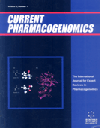- Home
- A-Z Publications
- Current Pharmacogenomics
- Previous Issues
- Volume 3, Issue 1, 2005
Current Pharmacogenomics - Volume 3, Issue 1, 2005
Volume 3, Issue 1, 2005
-
-
Saccharomyces Cerevisiae as a Genetic Model in Anticancer Therapy
More LessAuthors: J. E. Kurtz, P. Dufour, J. P. Bergerat and F. ExingerWith the recent sequencing of its entire genome, the yeast Saccharomyces cerevisiae has gained considerable interest in the field of anticancer research. The genetic properties of the yeast allow easy selection of a variety of mutants, as their related phenotypes provide valuable information on anticancer drugs effects in vivo. Moreover, the yeast has been extensively studied as a model system to decipher basic cellular proce Read More
-
-
-
The Genetic Regulation of ADPRT/PARP-1 in Aging and Cancer Susceptibility
More LessAuthors: Kristin L. Lockett, Isaac V. Snowhite and Jennifer J. HuThe ADP-ribosyltransferase (ADPRT) gene encodes the poly(ADP-ribose)polymerase-1 (PARP-1) enzyme, which plays critical roles in DNA-damage signaling and repair, cell death, maintenance of genomic stability, and carcinogenesis. It may also serve as a potential target for cancer therapy. In this review, we evaluate findings from animal model systems and molecular epidemiological studies to demonstrate the potential role of Read More
-
-
-
Bilirubin and the Genome: The Hereditary Basis of Unconjugated Neonatal Hyperbilirubinemia
More LessAuthors: Michael Kaplan and Cathy HammermanSevere neonatal unconjugated hyperbilirubinemia, with the risk of bilirubin encephalopathy or kernicterus in severe, untreated cases, occurs when bilirubin production exceeds the body's ability to eliminate it. The causes of neonatal hyperbilirubinemia are multifactorial and comprise increased hemolysis on the one hand, and diminished bilirubin conjugation on the other. In recent years, many of these etiologies have been found Read More
-
-
-
Influence of CYP2D6 Genetics on Opioid Kinetics, Metabolism and Response
More LessAuthors: Gerd Mikus and Johanna WeissPharmacogenetics does seem to play a key role in the use of so-called weak opioids. It has been shown for codeine, dihydrocodeine, oxycodone and hydrocodone, that their O-demethylation in the 3-position results in metabolites which have much stronger μ-receptor binding. These opioids may therefore exert their pharmacological actions predominantly through their O-demethylated metabolites. However, this metabolic st Read More
-
-
-
Multigenic Control of Drug Response and Regulatory Decision-Making in Pharmacogenomics: The Need for an Upper-Bound Estimate of Genetic Contributions
More LessAuthors: V. Ozdemir, W. Kalow, L. Tothfalusi, L. Bertilsson, L. Endrenyi and J. E. GrahamNature or nurture? To what extent genetics play a role in drug efficacy and safety? These questions are not new. They are however gaining increasing prominence with the implementation of pharmacogenomics in various facets of medicine ranging from therapeutics, drug development and regulatory science to research funding decisions. For predisposition to common complex diseases, twin and family studies have bee Read More
-
-
-
DNA Methylation in the Pathogenesis of Systemic Lupus Erythematosus
More LessAuthors: Amr H. Sawalha and Bruce RichardsonSome forms of drug-induced lupus may be due to inhibition of T cell DNA methylation. DNA methylation modifies gene expression. In general, methylation of regulatory elements suppresses gene expression, while hypomethylation promotes gene expression. Methylation patterns are replicated during mitosis by a family of DNA methyltransferases, whose expression is regulated in part by signals transmitted through th Read More
-
Most Read This Month
Article
content/journals/cpg
Journal
10
5
false
en


